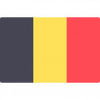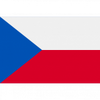Evoke the subdued essence and beauty of natural and historical elements with the Flexible Triad: Desaturated Cool Greens. This selection of colours is perfect for capturing the feelings of a rugged terrain with moss-covered stones or the muted tones of military unforms. Whether you are painting the mossy remains of ancient ruins, the elegant patina of old metalwork, these colours are ideal for painting weathered and worn materials and imbuing your miniatures with a sense of history and narrative. The colours in the triad are also perfect for creatures that inhabit enchanted forests such as the leafy form of an ent or a wood elf.
The Desaturated Cool Greens Triad is suitable for projects across all genres of miniature painting, from historical and military figures to fantasy creatures and sci-fi models.
The Flexible Triad: Desaturated Cool Greens consists of:
- Warpaints Fanatic: Evergreen Fog
- Warpaints Fanatic: Medieval Forest
- Warpaints Fanatic: Patagon Pine
- Warpaints Fanatic: Autumn Sage
- Warpaints Fanatic: Forest Faun
- Warpaints Fanatic: Mossy Green
The Flexible Colour Triad System is a segment, or family, of six colours that range from dark to light with a consistent hue. This system allows you to easily select paints that create a natural colour progression on your miniatures. This is an easy way to create a colour scheme for your miniature when army painting because you always have 27 Flexible Triads to choose from instead of mixing colours.
The system builds upon the traditional triad system by introducing more versatility and adaptability in colour selection, expanding the conventional three colours to six. This gives you almost endless possibilities for putting colours together within the triad.
When using a triad system, you usually select 3 colours (a base, a shade, and a highlight), depending on the level of contrast you want on your miniature. For instance, for minimal contrast, opt for 3 adjacent colours to achieve a smooth colour transition. For maximum contrast, use the lightest, middle, and darkest colour available in the flexible triad.
Select a minimum of three colours within the Flexible Triad: a base, a shade, and a highlight. The chosen colours can be either adjacent or spaced out, depending on the level of contrast you would like to achieve. The more spaced out, the greater the contrast.
- Begin by applying the basecoat of the darkest colour to establish a dark colour in the shadows and recesses of your miniature.
- Next, apply your midtone colour (the lighter tone within the Flexible Triad). Paint this over all areas, leaving the darkest basecoat colour in the recesses and shadowed areas. Keep repeating this step if you have more than one midtone, going lighter each time, and continue until you’re left with the lightest colour.
- Lastly, use the lightest colour to highlight the most prominent areas of the model, such as edges and raised surfaces. This will add definition and mimic the look of light catching on the miniature.
Tip: Blend the colours together smoothly to create a seamless transition between each shade. You can adjust the intensity of the colours by layering and blending them as needed. Experiment with different techniques to achieve the desired effect, such as dry brushing or layering thin glazes of paint.
Read Warpaints Fanatic: How to use Flexible Colour Triads for a more in-depth introduction to the Flexible Triad System and a step-by-step guide for how to use it.
Conforms to ASTM D-4236. Made in NO. Contents: WPF (UFI: T630-40ST-F00Y-A60U) UK: Warning. Contains: (1), reaction mass of (2). May cause an allergic skin reaction. Causes serious eye irritation. Wear protective gloves. IF ON SKIN: Wash with plenty of water. Dispose of contents according to local regulations.
(1): octhilinone (ISO), & 1,2-benzisothiazol-3(2H)-one
(2): 5-chloro-2-methyl-2H-isothiazol-3-one, & 2-methyl-2H-isothiazol-3-one (3:1)









 UNITED STATES From: 17,99 €
UNITED STATES From: 17,99 €
 UNITED KINGDOM From: 8,99 €
UNITED KINGDOM From: 8,99 €
 FRANCE From: 4,99 €
FRANCE From: 4,99 €
 GERMANY From: 5,99 €
GERMANY From: 5,99 €
 ITALY From: 8,99 €
ITALY From: 8,99 €
 NETHERLANDS From: 4,99 €
NETHERLANDS From: 4,99 €
 BELGIUM From: 4,99 €
BELGIUM From: 4,99 €
 DENMARK From: 4,99 €
DENMARK From: 4,99 €
 IRELAND From: 8,99 €
IRELAND From: 8,99 €
 SPAIN From: 8,99 €
SPAIN From: 8,99 €
 SWEDEN From: 6,99 €
SWEDEN From: 6,99 €
 AUSTRIA From: 7,99 €
AUSTRIA From: 7,99 €
 FINLAND From: 8,99 €
FINLAND From: 8,99 €
 PORTUGAL From: 8,99 €
PORTUGAL From: 8,99 €
 POLAND From: 7,99 €
POLAND From: 7,99 €
 CZECH REPUBLIC From: 7,99 €
CZECH REPUBLIC From: 7,99 €
 CROATIA From: 12,99 €
CROATIA From: 12,99 €
 HUNGARY From: 11,99 €
HUNGARY From: 11,99 €
 SLOVENIA From: 11,99 €
SLOVENIA From: 11,99 €
 LUXEMBOURG From: 4,99 €
LUXEMBOURG From: 4,99 €
 GREECE From: 15,99 €
GREECE From: 15,99 €
 ROMANIA From: 10,99 €
ROMANIA From: 10,99 €
 LATVIA From: 11,99 €
LATVIA From: 11,99 €
 BULGARIA From: 12,99 €
BULGARIA From: 12,99 €
 LITHUANIA From: 10,99 €
LITHUANIA From: 10,99 €
 ESTONIA From: 10,99 €
ESTONIA From: 10,99 €
 SLOVAKIA From: 10,99 €
SLOVAKIA From: 10,99 €
 UNITED STATES From: 17,99 €
UNITED STATES From: 17,99 €
 UNITED KINGDOM From: 8,99 €
UNITED KINGDOM From: 8,99 €
 FRANCE From: 4,99 €
FRANCE From: 4,99 €
 GERMANY From: 5,99 €
GERMANY From: 5,99 €
 ITALY From: 8,99 €
ITALY From: 8,99 €
 NETHERLANDS From: 4,99 €
NETHERLANDS From: 4,99 €
 BELGIUM From: 4,99 €
BELGIUM From: 4,99 €
 DENMARK From: 4,99 €
DENMARK From: 4,99 €
 IRELAND From: 8,99 €
IRELAND From: 8,99 €
 SPAIN From: 8,99 €
SPAIN From: 8,99 €
 SWEDEN From: 6,99 €
SWEDEN From: 6,99 €
 AUSTRIA From: 7,99 €
AUSTRIA From: 7,99 €
 FINLAND From: 8,99 €
FINLAND From: 8,99 €
 PORTUGAL From: 8,99 €
PORTUGAL From: 8,99 €
 POLAND From: 7,99 €
POLAND From: 7,99 €
 CZECH REPUBLIC From: 7,99 €
CZECH REPUBLIC From: 7,99 €
 CROATIA From: 12,99 €
CROATIA From: 12,99 €
 HUNGARY From: 11,99 €
HUNGARY From: 11,99 €
 SLOVENIA From: 11,99 €
SLOVENIA From: 11,99 €
 LUXEMBOURG From: 4,99 €
LUXEMBOURG From: 4,99 €
 GREECE From: 15,99 €
GREECE From: 15,99 €
 ROMANIA From: 10,99 €
ROMANIA From: 10,99 €
 LATVIA From: 11,99 €
LATVIA From: 11,99 €
 BULGARIA From: 12,99 €
BULGARIA From: 12,99 €
 LITHUANIA From: 10,99 €
LITHUANIA From: 10,99 €
 ESTONIA From: 10,99 €
ESTONIA From: 10,99 €
 SLOVAKIA From: 10,99 €
SLOVAKIA From: 10,99 €



